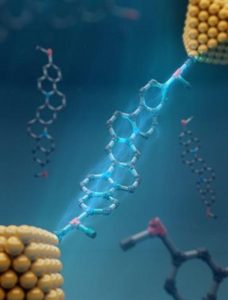Are Molecules the Key to Further Tech Miniaturization?
As electronic devices continue to shrink, physical size limitations are challenging Moore’s law, which predicts the doubling of transistor density on silicon microchips approximately every two years.
However, molecular electronics, which uses single molecules as the building blocks for electronic components, presents a potential solution for further miniaturization, but the dynamic nature of single-molecule components complicates the control of electrical current, affecting device performance and reproducibility.
Researchers at the University of Illinois Urbana-Champaign have developed a novel strategy to address this challenge by using molecules with rigid backbones, such as ladder-type molecules known for their shape persistence. They have also demonstrated a straightforward “one-pot” synthesis method to produce these molecules, which could lead to more stable and reliable molecular electronic devices.
“In the field of molecular electronics, you have to consider the flexibility and the motion of the molecules and how that affects the functional properties,” says Charles Schroeder, the James Economy Professor of Materials Science and Engineering and Professor of Chemical and Biomolecular Engineering.
They tackled this by preparing molecules with rigid backbones to maintain consistent conductivity regardless of molecular conformation. Traditional organic molecules are flexible, leading to multiple conformations with varying electrical conductance, sometimes as large as 1,000 times variance. By using shape-persistent ladder-type molecules, they achieved stable conductance in molecular junctions.

Credit: The Grainger College of Engineering at the University of Illinois Urbana-Champaign
Ladder-type molecules feature a sequence of chemical rings with shared atoms, which “locks” the molecule into a fixed conformation, minimizing conductance variation. This consistency is crucial for molecular electronics, where billions of components must have identical electronic properties. The variation in conductance has been a significant barrier to commercializing molecular electronic devices, and achieving precise control over molecular conductance could advance the science of ultra-small electronic devices.
The team published their research in Nature Chemistry.

